- eBox
- Domain Controll Unit
The domain control unit coordinates several nodes of a vehicle domain. The domain controller takes over computationally intensive tasks based on the data of the various bus nodes.
Different communication protocols allow project-related, flexible communication with the actuators/sensors using standard software components.
The central coordination and calculation of the domain functionality makes it possible to create complex scenarios that can be experienced by the customer while simplifying the E/E architecture at the same time.
- Realization of zone and add-on architecture
- Integration of virtual ECUs
- Replacement of HMI-devices

EBOX
UNIVERSAL AUTOMOTIVE ECU
With a wide range of automotive interfaces and an integrated Yocto Linux operating system, the eBox provides a universal automotive platform. Typical applications include Domain Control or Lighting Scenario Master in series-production vehicles with low volume count.
It is also a perfect solution for the integration of new devices and applications into existing vehicle networks or for test setups.
The eBox can be controlled via LIN, CAN, Ethernet or the integrated WiFi Hotspot. Among other things, the eBox can be remotely controlled via a tablet or computer using a customer-specific application.
In addition to the powerful Linux operating system, the eBox offers a real-time operating system on a separate microcontroller.
- Customizable controller with WiFi Hotspot
- Yocto Linux operating system, with 8GB Flash & 256 MB RAM
- Interfaces: 3xCAN, 1x LIN, 1x OABR, 8x analog Input, 4x digital I/Os
- Real-time operating system
- Extendible I/O interface
DOMAIN CONTROL UNIT
CONNECTING STANDARD BOARD NET WITH PRIVATE NETWORK FOR SPECIAL FUNCTIONS
The Domain Control Unit acts as a gateway to connect a private network for special functions to the standard vehicle electrical system via a robust and secure interface.
The use of two virtual ECUs, both based on AUTOSAR, results in a strict separation of base functionality and connectivity from additional applications.
This allows functions for special purpose cars (e.g. security vehicles, police cars, other derivatives, small volume series) to be introduced with minimal validation effort after SOP of the base vehicle.
Communication with the vehicle network is based on Ethernet or CAN. The special functions can be controlled either via CAN, LIN, PWM or Ethernet. In addition, High-side and Low-side power outputs as well as wake-up and diagnosable inputs for sensors and push buttons are available.
- Connects board communication system with special functions via Ethernet or CAN
- Controls special function directly with 250mA or 1A outputs
- 48 low power and 16 medium power outputs
- Communication via LIN, CAN, Ethernet
-
Digital and analog inputs, evaluation of PWM signals

